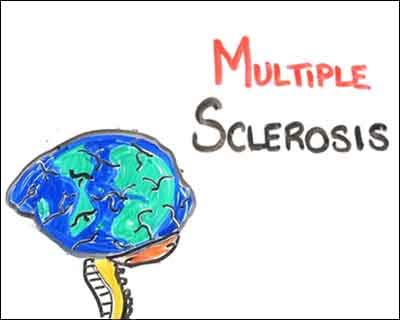- Home
- Editorial
- News
- Practice Guidelines
- Anesthesiology Guidelines
- Cancer Guidelines
- Cardiac Sciences Guidelines
- Critical Care Guidelines
- Dentistry Guidelines
- Dermatology Guidelines
- Diabetes and Endo Guidelines
- Diagnostics Guidelines
- ENT Guidelines
- Featured Practice Guidelines
- Gastroenterology Guidelines
- Geriatrics Guidelines
- Medicine Guidelines
- Nephrology Guidelines
- Neurosciences Guidelines
- Obs and Gynae Guidelines
- Ophthalmology Guidelines
- Orthopaedics Guidelines
- Paediatrics Guidelines
- Psychiatry Guidelines
- Pulmonology Guidelines
- Radiology Guidelines
- Surgery Guidelines
- Urology Guidelines
Loss of spinal nerve fibers not the only cause of disability in multiple sclerosis

Causes of Disability in Multiple Sclerosis
It is commonly thought that in MS, the loss of axons (nerve fibres) contributes to the chronic disability found in many patients. This has led to the wide use of MRI to measure the cross sectional area of the spinal cord in order to predict disability.
But researchers from Queen Mary University of London have now sampled spinal cords of thirteen people with MS and five healthy controls, and found that spinal cord cross sectional area is not a good predictor of axonal loss.
Lead researcher Klaus Schmierer said: "The lack of association between axonal loss and spinal cord cross sectional area significantly changes our understanding of chronic disability in MS.
"The nature of the spinal cord as a highly organised and largely autonomous network needs to be appreciated. We need to identify other factors which -- over and above axonal loss -- determine the collapse of the spinal cord network and lead to the functional deficits seen in MS.
"In spinal cord trauma, people with less than 10% of their spinal cord axons may still be able to have useful lower limb movement, but in MS, patients with as much as 40% of their axons retained, as shown in our study, are almost invariably wheelchair bound. So there is clearly something happening here which we've yet to understand."
The researchers say that finding other factors that cause the chronic disability seen in MS could help identify targets for new treatments.
The team's preliminary results indicate that the loss of synaptic connections in the MS spinal cord is substantial, and that this could be the missing link that is driving disability.
Full Article by : Natalia Petrova, Daniele Carassiti, Daniel R. Altmann, David Baker, Klaus Schmierer. Axonal loss in the multiple sclerosis spinal cord revisited. Brain Pathology, 2017; DOI: 10.1111/bpa.12516

Disclaimer: This site is primarily intended for healthcare professionals. Any content/information on this website does not replace the advice of medical and/or health professionals and should not be construed as medical/diagnostic advice/endorsement or prescription. Use of this site is subject to our terms of use, privacy policy, advertisement policy. © 2020 Minerva Medical Treatment Pvt Ltd